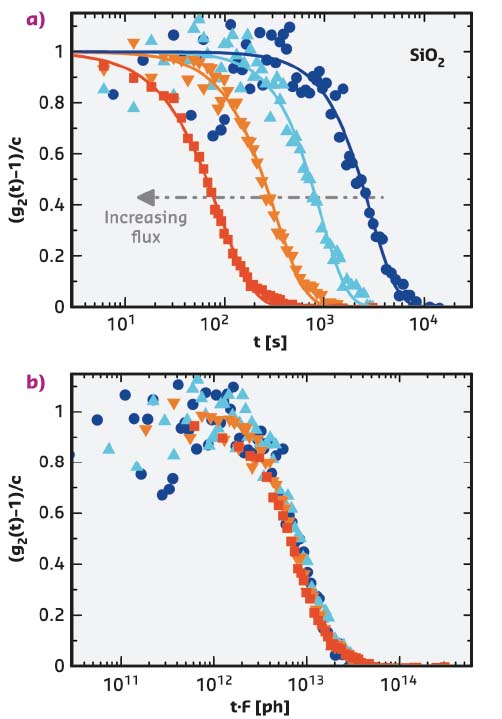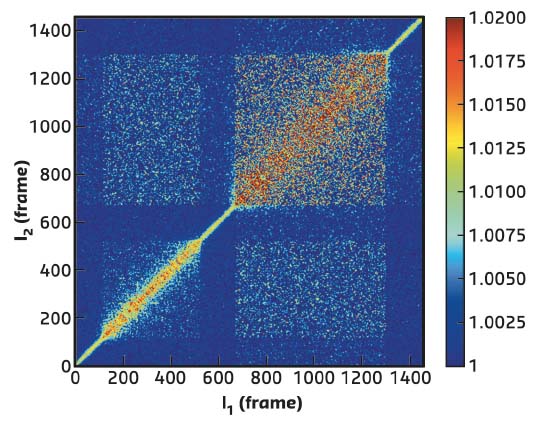- Home
- Users & Science
- Scientific Documentation
- ESRF Highlights
- ESRF Highlights 2017
- Complex systems and biomedical sciences
- X-rays induce dynamics in oxide glasses
X-rays induce dynamics in oxide glasses
High X-ray fluxes can alter the dynamical properties in hard materials, an effect that has to be considered in the analysis of X-ray data. This effect also provides an opportunity to study material properties, since the beam can probe – and even initiate – the dynamics.
Powerful X-ray sources such as diffraction-limited synchrotrons and free-electron lasers (FEL) are considered as the ultimate tools for the investigation of the microscopic properties of materials [1]. However, even with third-generation synchrotrons, it was realised that the intense beam can affect the material, e.g. biological and soft materials can suffer severe radiation damage. Despite this problem, such experiments nevertheless allow unique information to be gained about the material [2]. Similar effects have yet to be reported for hard materials; it has always been assumed that X-rays do not influence their properties. Now, by using X-ray photon correlation spectroscopy (XPCS) at beamline ID10, it has been discovered that the beam can indeed alter the properties of the sample in an important way.
The relaxation dynamics of oxide and metallic glasses were probed by varying the incoming X-ray flux. Figure 52a shows intensity auto-correlation curves measured in glassy SiO2 at ambient temperature and for a wave-vector Qp = 1.5 Å−1, corresponding to the position of the maximum in the static structure factor. The curves represent a measure of the degree of correlation between two configurations separated by a lagtime t, and the decay time, τ, which is the time necessary for structural rearrangements on a length scale covering a few Å. The dynamics of oxide glasses depends strongly on the intensity, being faster – i.e. with shorter decay time – for higher X-ray fluxes. This is confirmed by the observation that all data collapse onto a master curve when plotted as a function of time normalised by the flux (Figure 52b).
 |
|
Fig. 52: a) Intensity auto-correlation functions measured in SiO2 at T = 295 K and Qp = 1.5 Å−1 for different intensities. From left to right: F0 ≈ 1 · 1011 ph/s (squares), F1 ≈ 3 · 1010 ph/s (down-triangles), F2 ≈ 1.2 · 1010 ph/s (up-triangles) and F3 ≈ 3.6 · 109 ph/s (circles). b) The same data rescaled with respect to the flux. |
The observed effect cannot be classified as standard radiation damage since the induced dynamics is independent of the accumulated dose deposited on a particular sample position and the decay time is reversibly modified by changing the intensity of the beam. This is demonstrated in Figure 53, which shows the two-time correlation function measured while changing the beam attenuation without stopping the measurement. Each point of the two-time correlation function corresponds to the product of two images acquired at two different times [3]. The effect of the attenuators is signalled by the abrupt changes in the profile along the main diagonal, whose width is proportional to τ. The higher the incoming intensity, the faster the dynamics and thus the thinner the intensity profile. For a fixed incoming intensity, the profile remains constant with time thus implying that the corresponding dynamics is stationary and does not depend on the total accumulated dose.
 |
|
Fig. 53: Two-time correlation function measured by varying the intensity of the incoming flux. Left to right: F0 ≈ 1 · 1011 ph/s, F1 ≈ 3 · 1010 ph/s, F0 ≈ 1 · 1011 ph/s, F2 ≈ 1.2 · 1010 ph/s, and F0 ≈ 1 · 1011 ph/s. Each frame corresponds to a lagtime Δt = 6.15 s. |
The static structure was not affected by the X-rays, suggesting that this is not the usual radiation damage found in soft materials, but rather can be attributed to radiolysis, i.e. to the interaction between localised electronic excitations created by the X-rays and phonons of the material. In contrast, metallic glasses do not show this effect because their electronic excitations delocalise faster on the fs timescale.
This work demonstrates that high X-ray intensities can affect even hard materials. Therefore, high X-ray fluxes can be used to probe the material and also as a pump for the atomic motion, providing unique information on the system.
The observed behaviour is likely to occur in a variety of materials and its strength will be amplified dramatically at next generation synchrotrons and FELs [1], where techniques such as XPCS that use intense coherent beams will be based on fs pulses with intensities as high as current synchrotrons provide in one second [4].
Principal publication and authors
Hard X-rays as pump and probe of atomic motion in oxide glasses, B. Ruta (a,b), F. Zontone (b), Y. Chushkin (b), G. Baldi (c), G. Pintori (c), G. Monaco (c), B. Rufflé (d) and W. Kob (d), Scientific Reports 7, 3962 (2017); doi: 10.1038/s41598-017-04271-x.
(a) Université Claude Bernard Lyon 1, CNRS, Institut Lumière Matière, Villeurbanne (France)
(b) ESRF
(c) Dipartimento di Fisica, Trento University, Povo (Italy)
(d) Laboratoire Charles Coulomb (L2C), UMR 5221 CNRS-Université de Montpellier (France)
References
[1] P.G. O’Shea and H.P. Freund, Science 292, 8 (2001).
[2] M. Weik et al., PNAS 97, 623-628 (2000).
[3] R. Neutze et al., Nature 406, 752-757 (2000).
[4] B. Ruta et al., Phys Rev Lett. 109, 165701 (2012).



